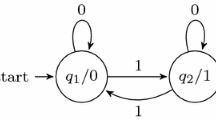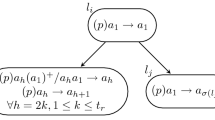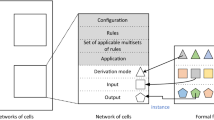Abstract
This work continues the investigations of introducing probabilities to spiking neural P systems, SN P systems in short—membrane computing models inspired from biological spiking neurons. A particular interest for SN P systems in this work is the nondeterministic selection of applicable firing rules. Rules represent the possible reactions of a neuron to the number of electrical impulses, or spikes, present. Intuitively, having nondeterministic selection can be interpreted as having a random choice with equal probabilities for all options. This seems unnatural in some biological sense, since some reactions are more active than others in general as emphasized in Obtułowicz and Păun, BioSystems 70(2):107–121, 2003. Results found that the stochastic process introduced to the nondeterministic selection of firing rules also applies to application of rules in general whether the rule is for firing or forgetting and whether a single rule is applicable or multiple. This work proposes SN P systems with stochastic application of rules, \(\star \)SN P systems in short. \(\star \)SN P systems are variants which introduce a stochastic process a priori to the application of rules in SN P systems.






Similar content being viewed by others
Notes
stochastic application of rules
References
Adorna, H. N. (2020). Computing with sn p systems with i/o mode. Journal of Membrane Computing, 2(4), 230–245.
Cabarle, F. G. C., Adorna, H. N., Jiang, M., & Zeng, X. (2017). Spiking neural P systems with scheduled synapses. IEEE Transactions on Nanobioscience, 16(8), 792–801.
Cabarle, F. G. C., Adorna, H. N., Pérez-Jiménez, M. J., & Song, T. (2015). Spiking neural p systems with structural plasticity. Neural Computing and Applications, 26(8), 1905–1917.
Cattani, S., Segala, R., Kwiatkowska, M., & Norman, G. (2005). Stochastic transition systems for continuous state spaces and non-determinism. In: International conference on foundations of software science and computation structures (pp. 125–139). Springer.
Cavaliere, M., & Mura, I. (2008). Experiments on the reliability of stochastic spiking neural P systems. Natural Computing, 7(4), 453–470.
Colomer, M. À., Margalida, A., & Pérez-Jiménez, M. J. (2013). Population dynamics P system (PDP) models: a standardized protocol for describing and applying novel bio-inspired computing tools. PloS One, 8(4), e60698.
de la Cruz, R. T. A., Cabarle, F. G., & Adorna, H. N. (2019). Generating context-free languages using spiking neural p systems with structural plasticity. Journal of Membrane Computing, 1(3), 161–177.
Fu, K. (1970). 11 stochastic automata as models of learning systems. In Mathematics in science and engineering (Vol. 66, pp. 393–431). Elsevier. https://www.sciencedirect.com/science/article/pii/S0076539208605019
Ibarra, O. H., Pérez-Jiménez, M. J., & Yokomori, T. (2010). On spiking neural p systems. Natural Computing, 9(2), 475–491.
Ibarra, O.H., & Woodworth, S. (2006). Characterizations of some restricted spiking neural P systems. In: International workshop on membrane computing (pp. 424–442). Springer.
Ionescu, M., Păun, G., & Yokomori, T. (2006). Spiking neural P systems. Fundamenta Informaticae, 71(2, 3), 279–308.
Jiang, Y., Su, Y., & Luo, F. (2019). An improved universal spiking neural p system with generalized use of rules. Journal of Membrane Computing, 1(4), 270–278.
Jimenez, Z. B., Cabarle, F. G. C., de la Cruz, R. T. A., Buño, K. C., Adorna, H. N., Hernandez, N. H. S., et al. (2019). Matrix representation and simulation algorithm of spiking neural p systems with structural plasticity. Journal of Membrane Computing, 1(3), 145–160.
Kasabov, N. (2010). To spike or not to spike: A probabilistic spiking neuron model. Neural Networks, 23(1), 16–19.
Maass, W. (1996). On the computational power of noisy spiking neurons. In: Advances in neural information processing systems (pp. 211–217).
Madhu, M. (2003). Probabilistic rewriting P systems. International Journal of Foundations of Computer Science, 14(01), 157–166.
Minsky, M. L. (1967). Computation. Englewood Cliffs: Prentice-Hall.
Narendra, K. S., & Thathachar, M. A. (1974). Learning automata—a survey. IEEE Transactions on Systems, Man, and Cybernetics, 4, 323–334.
Nishida, T. Y. (2002). Simulations of photosynthesis by a \(k\)-subset transforming system with membrane. Fundamenta Informaticae, 49(1–3), 249–259.
Obtulowicz, A. (2013). 24 biologically plausible applications of spiking neural p systems for an explanation of brain cognitive functions. In: M. Gheorghe, G. Păun, M.J. Pérez-Jiménez, G. Rozenberg (Eds.), Research frontiers of membrane computing: open problems and research topics, 5, chap. 23 (pp. 547–623). International Journal of Foundations of Computer Science (2013). 10.1142/S0129054113500202. https://doi.org/10.1142/S0129054113500202.
Obtułowicz, A., & Păun, G. (2003). (in search of) probabilistic P systems. BioSystems, 70(2), 107–121.
Ochirbat, O., Ishdorj, T. O., & Cichon, G. (2020). An error-tolerant serial binary full-adder via a spiking neural p system using hp/lp basic neurons. Journal of Membrane Computing, 2(1), 42–48.
Pérez-Jiménez, M. J., & Romero-Campero, F. J. (2006). P systems, a new computational modelling tool for systems biology. In Transactions on computational systems biology VI (pp. 176–197). Springer.
Pescini, D., Besozzi, D., Mauri, G., & Zandron, C. (2006). Dynamical probabilistic P systems. International Journal of Foundations of Computer Science, 17(01), 183–204.
Rossello, J. L., Canals, V., Morro, A., & Oliver, A. (2012). Hardware implementation of stochastic spiking neural networks. International Journal of Neural Systems, 22(04), 1250014.
Sipser, M. (2012). Introduction to the Theory of Computation. Cengage Learning.
Stirzaker, D. (2005). Stochastic Processes & Models. Oxford: Oxford University Press.
Suzuki, Y., Fujiwara, Y., Takabayashi, J., & Tanaka, H. (2000). Artificial life applications of a class of P systems: Abstract rewriting systems on multisets. In Workshop on membrane computing (pp. 299–346). Springer.
Verlan, S., Freund, R., Alhazov, A., Ivanov, S., & Pan, L. (2020). A formal framework for spiking neural p systems. Journal of Membrane Computing, 2(4), 355–368.
Von Neumann, J., & Kurzweil, R. (2012). The computer and the brain. Yale University Press.
Xu, Z., Cavaliere, M., An, P., Vrudhula, S., & Cao, Y. (2014). The stochastic loss of spikes in spiking neural P systems: Design and implementation of reliable arithmetic circuits. Fundamenta Informaticae, 134(1–2), 183–200.
Zhang, G., Rong, H., Neri, F., & Pérez-Jiménez, M. J. (2014). An optimization spiking neural P system for approximately solving combinatorial optimization problems. International Journal of Neural Systems, 24(05), 1440006.
Zhu, M., Yang, Q., Dong, J., Zhang, G., Gou, X., Rong, H., Paul, P., & Neri, F. (2020). An adaptive optimization spiking neural p system for binary problems. International Journal of Neural Systems 2050054. https://www.worldscientific.com/doi/abs/10.1142/S0129065720500549
Acknowledgement
F.G.C. Cabarle thanks the support from the DOST-ERDT project; the Dean Ruben A. Garcia PCA AY2017–2020. H. Adorna would like to thank supports from DOST-ERDT project since 2009 until present; the Semirara Mining Corp. Professorial Chair Award since 2015 until present. The RLC grant from UPD - OVCRD 2019–2020.
Author information
Authors and Affiliations
Corresponding author
Additional information
Publisher's Note
Springer Nature remains neutral with regard to jurisdictional claims in published maps and institutional affiliations.
Rights and permissions
About this article
Cite this article
Lazo, P.P.L., Cabarle, F.G.C., Adorna, H.N. et al. A return to stochasticity and probability in spiking neural P systems. J Membr Comput 3, 149–161 (2021). https://doi.org/10.1007/s41965-021-00072-4
Received:
Accepted:
Published:
Issue Date:
DOI: https://doi.org/10.1007/s41965-021-00072-4




